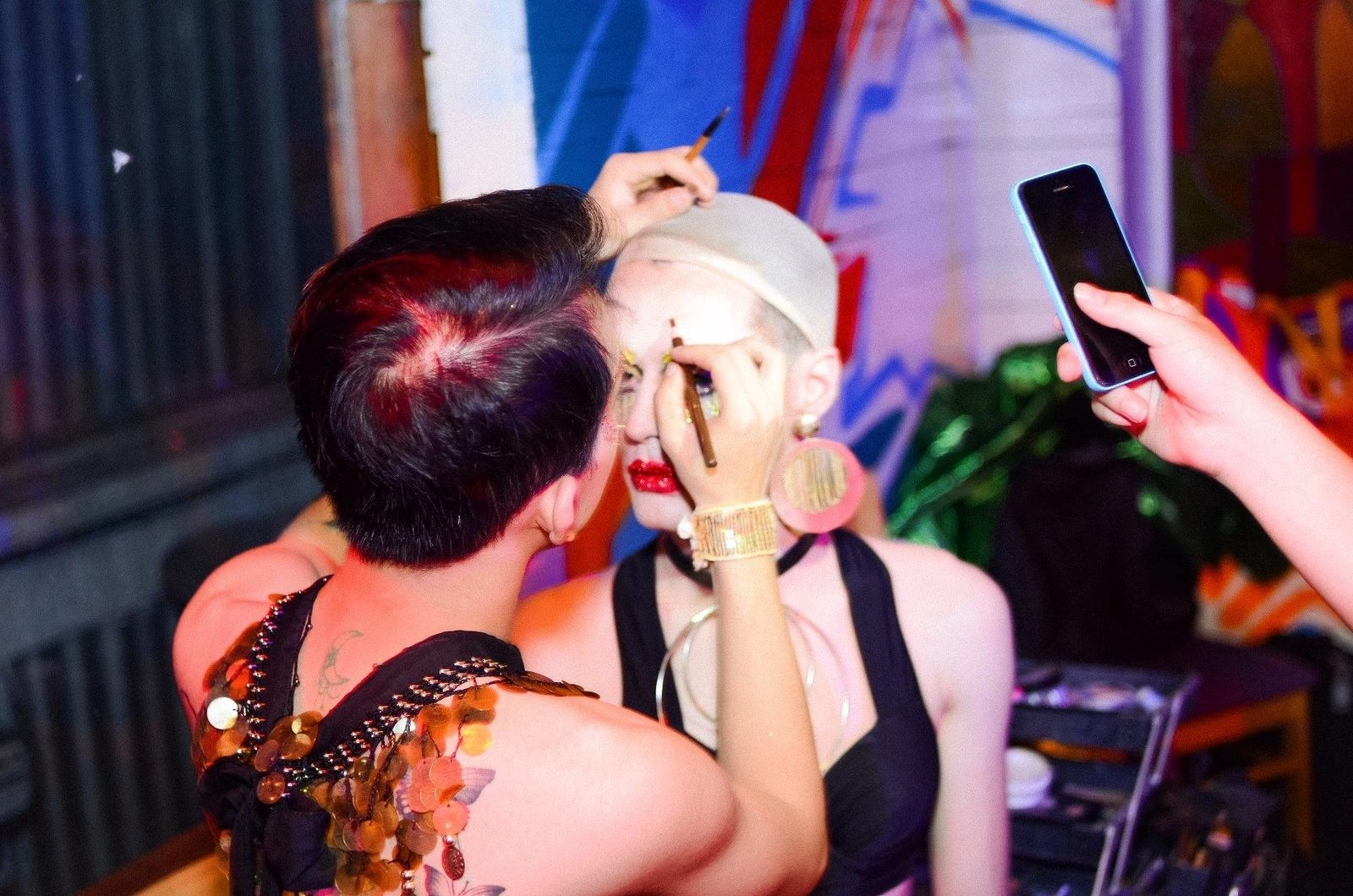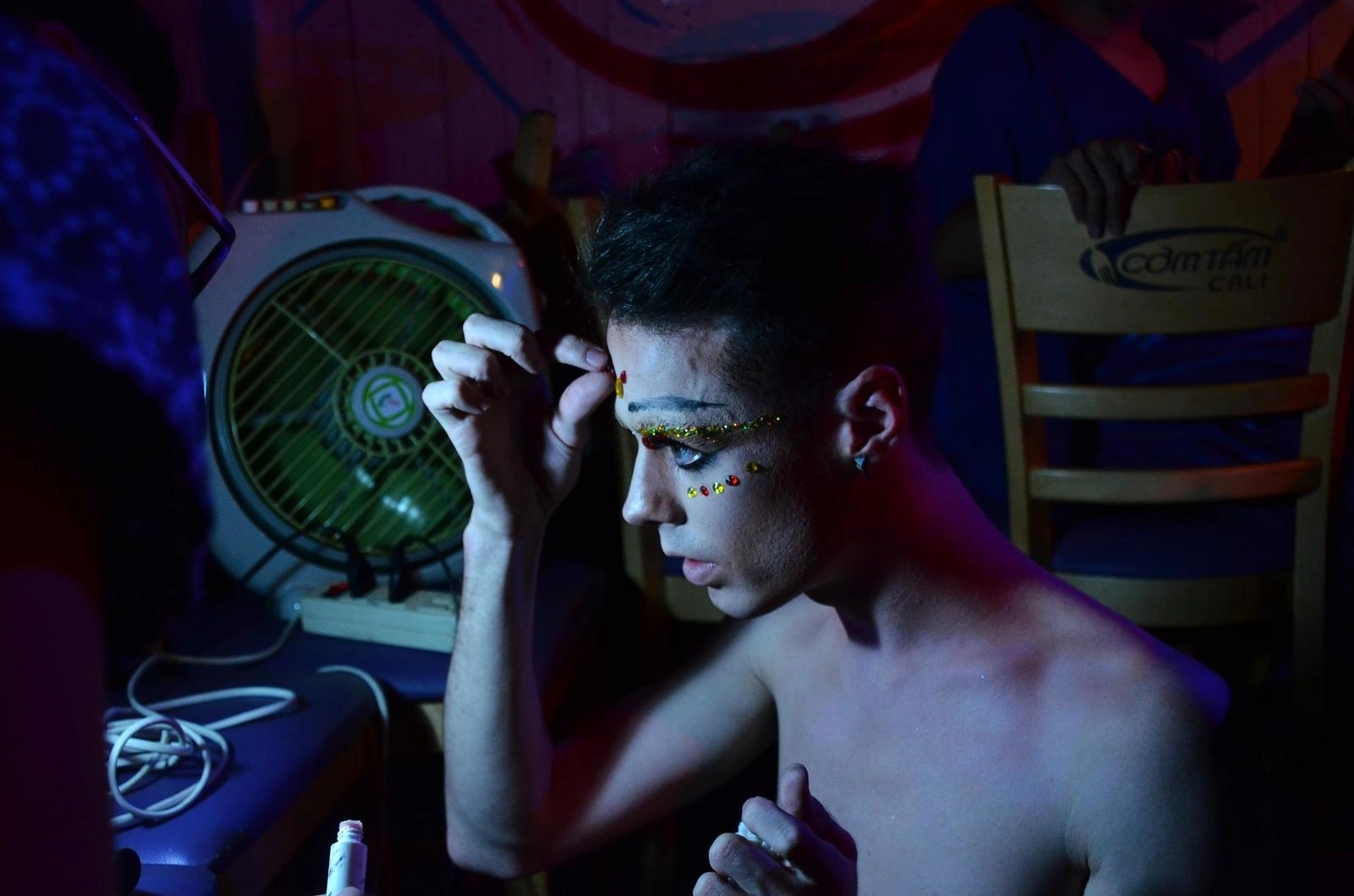
“Are you guys ready for the show?”
The audience cheers yes as Ricardo Glencasa flounces into the room in a pink, flouncy dress.
Every weekend, hundreds of people flock to a bar in District 1 in Saigon and enjoy performances by Drag Queens.
When the applause fades in the glimmering light, Ricardo cannot hide the delight of an artist loved by his fans.
In Vietnam since 2017, Ricardo works as an English teacher. He goes to class in formal vests and pants.
But as the night falls, he dons gorgeous gowns, make-up and wigs to become a drag queen, theater slang for men dressed as women.
Most drag queens are homosexual men, but many women and heterosexual people also use drag to unlease their creativity.
"I was bullied by my friends during childhood, and as an adult, I was discriminated against by society for my difference. This is also what my family forbid me to do. But now on stage, I am loved for my own difference," Ricardo told VnExpress.
Got caught early
He has not forgotten the terrifying moments he experienced as he watched TV with his dad and listened to jokes about gay people on the news. He was frightened that his father might know he was gay, just like those people on TV, Ricardo says.
Ricardo grew up in a poor area in the industrial city of Birmingham in England. When he was four, Ricardo realized that he was different from other boys. When he was six, his mother caught him wearing his sister’s dress and dancing on her bed.
"I grew up in an area... full of drugs, full of fighting. It was really a bad place to grow up... I grew up in an area where you could not be gay.”
At school, whenever he was asked, "Are you gay?," Ricardo just kept silent. The more reserved he became, the more he was bullied. It would start with a few “jokes” and extend into fights.

In grade six, Ricardo went to school for the year-ending sports tournament, excited about the upcoming summer holiday. However, the joy soon ended with three successive run-ins with bullies. “I was crying my eyeballs out.”
Ricardo spent the rest of his childhood in confusion. "As a child, you’re just being yourself, you are not trying to be a woman or anything."
Ricardo could not understand why he was being ridiculed and bullied for leading a normal life. As a child, Ricardo enjoyed reading, climbing, playing soccer and computer games. The only "girly" thing about him might have been the Spice Girls sticker on his door, he joked.
He remembers a school trip when he and his three straight friends got some extra-large shirts that extended to the knees. “I was just having fun with my friends.”
But his father had a different view. “Why are you wearing that dress?” The shirt was just a joke with friends but his father saw it as a feminine thing. Ricardo realized then that "I am never gonna be up to please him."
Fearing rejection by family and friends, Ricardo was completely alone on the journey in exploring his sexual orientation and gender identity. Without anyone to share his problems with, he fell into depression and had suicidal thoughts very early. “When I was young, if there was a ‘straight’ pill that could turn me straight, I would have taken it. It was too horrible,” Ricardo recalled.A lack of safe space
"Being a minority in the society, homosexual, bisexual and transgendered people (LGBT) lack the safe space to share issues they have,” said Hoang Giang Son, gender equality coordinator at the Institute for Studies of Society, Economy and Environment (iSEE).
Son attributed this problem to the fact that teachers do not include information on LGBT community in their syllabus, and textbooks do not cover content about sexual orientation and gender identity. Within the family, the generation gap also contributes to the issue.
At the age of adolescence, Ricardo started chatting with strangers online and went to bars, seeking answers to the confusion about himself.
Terrified by his childhood experiences, Ricardo did not dare to disclose his sexual orientation and communicate with the gay people who had come out. “I have been to many dark places because I was too scared to come out as a gay person.”
He often used alcohol to gather courage and contact men. “No one is around, I am drunk. I put myself into dangerous situations.” Once, in a stuffy, gloomy apartment, the 17-year-old Ricardo was asked to do things he did not want to do. “The fear of people knowing I am gay pushes me in to this really dark, dangerous situations,” Ricardo said.

Drag Queen - the remedy for the broken heart
Ricardo did not reveal his sexual orientation to his friends until he was 21. And only a few days before he left for Vietnam, Ricardo confessed to his mother. He was 26.
"It was very late to come out,” said Ricardo.
According to a 2013 research by Pew Research Center on acceptance of homosexuality conducted in 39 countries, 76 percent of British respondents support homosexuality, making the U.K among five European countries with highest homosexuality acceptance rate.
But Vietnam, considered a far more conservative country than the U.K, has turned out to be the place where Ricardo has felt free to express himself and embrace his true self.
"People think that a drag queen wants to be a woman. I don’t want to be a woman, I’m happy to be a man, biologically. I just have a woman inside me, she wants to come out sometimes. She is fabulous and she wants to have fun.”

The drag culture has crossed the line between the conventional definition of “man” and “woman”, said Phung Ha Phuong Thao, a Hanoi-based activist for gender equality. Thao explained that a man is usually viewed as a strong person and the breadwinner of the family and society, while woman is seen to have gentle, weak characteristics, taking care of more trivial jobs.
“To be a drag artist means to be anybody as long as you are happy. Drag does not only address the gender issue, it also tells the story of people expressing themselves, the story of diversity and of personal freedom,” Thao said.
This is not understood so well in Vietnam.
One study found that most Vietnamese people do not understand the LBGT community well, and that men dressing like women are the most vulnerable group.
“Their different looks annoy or provoke hostility of the patriarchal society in Vietnam, where the values of men and masculinity are exalted,” the study found.
In this context, Ricardo has been privileged in the acceptance he has found, but he is aware of the struggles others have to endure.
During almost two years in Vietnam, Ricardo has never been offended by verbal or violent attacks. "Or maybe they do but I do not understand Vietnamese," Ricardo joked.
Ricardo faces problems like buying costumes in Saigon. He is tall, so he has to buy custom-made clothes or get them from abroad. In only six months, he has spent VND70 million ($3,000) on cosmetics and costumes.
Meanwhile, a Drag Queen is paid just VND500,000 ($21.2) to 1 million ($42.4) per show. Every month, the performers only get paid for one or two shows. On other days, they show up on stage out of personal passion or join community events.
On the second floor of the nightclub, Ricardo’s group change clothes and rehearse some dance moves. In the dim light, they smoke, chat and laugh freely.
In the restroom, there is a constant sound of torn duck tape. Ricardo explained that it was a "tucking" trick to hide the male genital inside. "But the corset is the most uncomfortable thing, sometimes I almost suffocate."
Ricardo sprays hair gel directly into his face, explaining "This helps to maintain the makeup in the hot, humid weather of Saigon". He also uses double-sided tape to hold the earings fixed and shows me his paper glue bar. "Paper glue is the best to groom your eyebrow".

"It is not easy to be a drag queen," Ricardo admitted. Many hours dancing on 20-centimeter high heels have resulted in stiff legs and back pain.
Thao has followed many drag queens on their shows. She said make-up usually takes 4-5 hours. If the show starts at 11 p.m, a drag queen needs to prepare at six.
“Payment is usually very low, just enough to purchase meals and cosmetics. They must love the limelight so much to have the motivation to continue," she said.
Looking forward to the next 20 years, Ricardo finds himself at the age of 50, living happily on an island in Thailand with his spouse and a wardrobe full of Drag costumes.
Even further, Ricardo sees his friends attending his funeral in fancy costumes. And drag queens, wearing wide black hats and graceful heels, would take his coffin out of the church.
Returning from his daydream, Ricardo sighs and says he has not confessed to his father that he is gay. “But I do not feel the need to come out to him anymore.”
“I have accepted myself. I am celebrating myself.”
Story by Hanh Pham